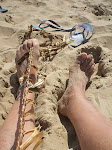These pretty, plaited palm garlands
are possibly made in many places around the world, but I learnt about them in
Tamil Nadu in Southern India.
They were being made by a rural
self-help womens co-operative and exported to charity and fair trade shops in Europe
and America for
sale as Christmas decorations.
They are an excellent product for a co-op like this, where
the women are not trained weavers but they can learn very quickly how to make
them. It is also portable work that allows
the women to carry it with them and continue whilst walking
to and from their homes or waiting for buses. They get paid by the piece so being
able to work whenever they have a chance is an important factor for them. As an
export product it also works well because
they pack into a neat, solid tube that takes up little space.
Made from locally harvested
coconut palm leaf and natural
dyes they are, almost, a perfectly sustainable
product, the only compromise being the lack of a local
market which requires them to be transported long distances.
I was invited to the co-op partly to help them develop some new designs, so the women taught me how to prepare and split the palm leaf and weave these decorations. When I returned to London I developed quite a few variations on the theme that would still pack up small and were not too complicated to produce, which I gave to them. I also added a few other more complicated items such as three–dimensional stars, but I never had any feedback and my life moved on, so I don’t know if they ever used any of my designs or not. I hope they did and that they sold well for them.
I was invited to the co-op partly to help them develop some new designs, so the women taught me how to prepare and split the palm leaf and weave these decorations. When I returned to London I developed quite a few variations on the theme that would still pack up small and were not too complicated to produce, which I gave to them. I also added a few other more complicated items such as three–dimensional stars, but I never had any feedback and my life moved on, so I don’t know if they ever used any of my designs or not. I hope they did and that they sold well for them.
 |
| Variations on the theme |
It is a bit late for Christmas decorations this year, but
these garlands will work just as well for other festive occasions and, maybe, in an idle moment over the festive
season you might like to make some guilt free decorations for next year out of
the mountains of packaging that will inevitably accumulate. So here are the
instructions for making a similar garland. As palm
leaf is not readily available everywhere I am showing you how to make this basic
simple woven spiral decoration using tetra pak, which is available pretty much everywhere. It can also
be worked with coloured papers and plastics, bark and leather among other many
other things.
Once you have got the technique it can be varied in many
ways simply by increasing or decreasing the width of the strips or
increasing/decreasing the number of weavers. If you get the bug you can try double linked chains, mixing
materials, threading other materials
through the loops… you get the idea.
For this one you will need tetra pak strips 1cm wide and as long as possible. Here are a
couple of videos to help you make them. This one shows how to cut the cartons
and this one shows you how to make a simple wire gauge to help cut them
evenly.
Then you just need to watch this video which shows you how
to weave them.
At the beginning to hold everything together I use a staple,
but just one end of the staple goes through the strips so that the strips
can be easily separated out. Once you get started you just keep going for as long as you like, it is really only one movement repeated ad infinitum. If you need to join strips you can overlap the two ends and work with the two together for a bit, but
its probably easier for a novice to just staple them together.















































